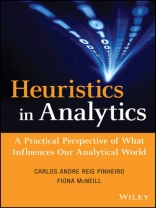Employ heuristic adjustments for truly accurate analysis
Heuristics in Analytics presents an approach to analysis
that accounts for the randomness of business and the competitive
marketplace, creating a model that more accurately reflects the
scenario at hand. With an emphasis on the importance of proper
analytical tools, the book describes the analytical process from
exploratory analysis through model developments, to deployments and
possible outcomes. Beginning with an introduction to heuristic
concepts, readers will find heuristics applied to statistics and
probability, mathematics, stochastic, and artificial intelligence
models, ending with the knowledge applications that solve business
problems. Case studies illustrate the everyday application and
implication of the techniques presented, while the heuristic
approach is integrated into analytical modeling, graph analysis,
text analytics, and more.
Robust analytics has become crucial in the corporate
environment, and randomness plays an enormous role in business and
the competitive marketplace. Failing to account for randomness can
steer a model in an entirely wrong direction, negatively affecting
the final outcome and potentially devastating the bottom line.
Heuristics in Analytics describes how the heuristic
characteristics of analysis can be overcome with problem design,
math and statistics, helping readers to:
* Realize just how random the world is, and how unplanned events
can affect analysis
* Integrate heuristic and analytical approaches to modeling and
problem solving
* Discover how graph analysis is applied in real-world scenarios
around the globe
* Apply analytical knowledge to customer behavior, insolvency
prevention, fraud detection, and more
* Understand how text analytics can be applied to increase the
business knowledge
Every single factor, no matter how large or how small, must be
taken into account when modeling a scenario or event–even the
unknowns. The presence or absence of even a single detail can
dramatically alter eventual outcomes. From raw data to final
report, Heuristics in Analytics contains the information
analysts need to improve accuracy, and ultimately, predictive, and
descriptive power.
İçerik tablosu
Preface xi
Acknowledgments xix
About the Authors xxiii
Chapter 1: Introduction 1
The Monty Hall Problem 5
Evolving Analytics 8
Summary 18
Chapter 2: Unplanned Events, Heuristics, and the Randomness in Our World 23
Heuristics Concepts 26
The Butterfly Effect 30
Random Walks 37
Summary 44
Chapter 3: The Heuristic Approach and Why We Use It 45
Heuristics in Computing 47
Heuristic Problem-Solving Methods 51
Genetic Algorithms: A Formal Heuristic Approach 54
Summary 67
Chapter 4: The Analytical Approach 69
Introduction to Analytical Modeling 71
The Competitive-Intelligence Cycle 74
Summary 97
Chapter 5: Knowledge Applications That Solve Business Problems 101
Customer Behavior Segmentation 102
Collection Models 106
Insolvency Prevention 113
Fraud-Propensity Models 120
Summary 127
Chapter 6: The Graph Analysis Approach 129
Introduction to Graph Analysis 130
Summary 143
Chapter 7: Graph Analysis Case Studies 147
Case Study: Identifying Influencers in Telecommunications 149
Case Study: Claim Validity Detection in Motor Insurance 162
Case Study: Fraud Identification in Mobile Operations 178
Summary 188
Chapter 8: Text Analytics 191
Text Analytics in the Competitive-Intelligence Cycle 193
Linguistic Models 198
Text-Mining Models 200
Summary 207
Bibliography 209
Index 217
Yazar hakkında
CARLOS ANDRE REIS PINHEIRO is Visiting Professor at KU Leuven, Belgium. He headed the Analytical Lab at Oi in Brazil, one of the largest telecommunications companies in Latin America. Pinheiro has conducted Postdoctoral Research at Katholieke Universiteit Leuven, Belgium, Université de Savoie, France and Dublin City University, Ireland. He holds a Ph D in Engineering from Federal University of Rio de Janeiro, Brazil. He worked at Brazil Telecom for almost ten years and also accomplished postdoctoral research at IMPA, Brazil, one of the most prestigious mathematical institutions in the world. He has published several papers in international journals and conferences and has four books (all in Portuguese) that focus on the internet, database, web warehousing, and analytical intelligence. He is the author of Social Network Analysis in Telecommunications, published by Wiley.
FIONA Mc NEILL has applied analytics to business problems since she began her career in 1992 and has consistently helped companies benefit from strategic use of data and analytics. Throughout her career, she has been affiliated with data and technology companies, from information and survey providers, IBM Global Services and for over fifteen years, at SAS. Mc Neill has published in academic journals, conducted education seminars and presented at both academic and industry conferences over the course of her career. She holds an M.A. in Quantitative Behavioral Geography from Mc Master University, and graduated cum laude with a B.Sc. in Bio-Physical Systems, University of Toronto.












